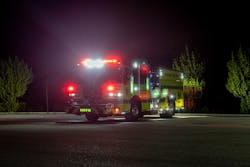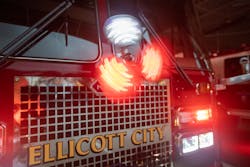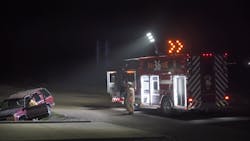Prior to the advent of motorized apparatus, it was common for runners to precede hand-drawn engines to clear the streets. Even as vehicles progressed, early apparatus warning systems were rudimentary. Bells, gongs, whistles and hand-cranked sirens were typical. Early electrical systems were rather primitive, and lights were few and far between.
The first fire apparatus that I drove in my fire service career was an open-cab 1950s-era vintage pumper. It had a rotating sealed-beam beacon, a siren/light combination on the nose and a mechanical siren on the bumper. When all three of these devices were used simultaneously, the headlights nearly went out from the electrical drain.
Jump ahead to recent times: The industry expanded to include halogen bulbs and electronic sirens, which sometimes were packaged in light bars. Over time, these devices became increasingly aerodynamic. Strobes also entered the picture.
Since then, the effectiveness and options of audio and visual warning devices increased, and with good reason. Not only are there more automobiles today than in the past, but they have better insulation and louder stereos and are operated by drivers who sometimes are distracted by their cellphones. It takes some doing to get their attention.
NFPA 1901: Standard for Automotive Fire Apparatus devotes an entire chapter to “low-voltage electrical systems and warning devices,” which contains recommendations on size, location and color of emergency lights. Sirens also are covered.
Light and sound science
To understand how recent improvements in warning devices help, it’s important to understand how and why people react—or sometimes don’t—to them. Dr. Stephen Solomon, himself a volunteer firefighter, has spent more than 50 years researching this subject. In fact, his name is synonymous with the introduction to the fire service of lime green apparatus in the 1970s.
“To get a safer apparatus, we must talk about visibility and audibility,” Solomon tells Firehouse Magazine. “Everything is a package. These two things don’t operate independently.
“Cars are built to be silent, to shut out road noise,” Solomon adds. “By the time that [a driver] figures out where the siren is coming from, it is often past [that person’s] point of no return. Because sound waves bounce, it is difficult to tell their directionality.”
Light location and action also are factors, but there is no single solution. Solomon notes, “A light that’s placed at the midline of the grille of the apparatus is at about the height of the rearview mirror of the automobile that’s ahead of you. To have that in motion is a particularly powerful device. It does not, however, do well with tractor trailers or very large trucks, because those vehicles don’t use a centerline mirror.”
Solomon believes that people struggle with the rear lights on apparatus and what those lights do and don’t do, and he contends that an apparatus can have too many flashing lights. Drivers must recognize that they are being given a message.
“What I found to be particularly effective at night, especially if we were going to be on the scene for a while, was raising a light tower all the way up and having the lights shine straight down,” Solomon explains. “Not only does it provide illumination for the firefighters on the scene, but it also sends a clear message that something is happening on the highway.”
Solomon went on to say that the nonstandardized colors that are employed in emergency lighting throughout the United States can be problematic, which is a point that was echoed in 2019 by the Emergency Responder Safety Institute.
In regard to overcoming acoustic isolation, James Stopa of Whelen Engineering offers his company’s solution. “Lower-frequency audible warning systems have been developed to overcome this challenge. Similar to subwoofers you are likely familiar with in your home music system, the Whelen Howler produces a much lower frequency sound than traditional electronic sirens.”
Stopa says that the science that’s behind this concept is that high-frequency sound is projected in one direction, and a second low-frequency sound is projected in an omnidirectional pattern.
“Low-frequency sound waves can penetrate structures more effectively than high-frequency sound waves,” Stopa adds. “This concept helps get the audible emergency warning signal inside of cars [that have] increased sound insulation.”
From a lighting standpoint, the continued evolution of LEDs is the story. Even the long-utilized Roto-Ray has made the conversion, according to Linda Slepetz of Roto-Ray. “LEDs have also vastly increased the visibility and downrange effectiveness of our product,” she notes.
Federal Signal’s Jim Sortino reports that his company introduced the LED Traffic Clearing Light (TCL) to alert drivers as a fire apparatus or ambulance approaches from the rear. “Unlike common perimeter lights that provide warning around the apparatus, the LED TCL’s optics and unique sequence of flash patterns direct light to the driver’s rearview mirror.”
Matt Murray, who is vice president of strategic sales for TOMAR Electronics, says that his company’s contribution to the advancement of warning lights comes in the form of lights and lightbars that have the capability to be dual mode, not just dual color. “The effect of these dual-mode lights is a dramatic increase in scene lighting. While standard scene lighting points down on the ground, with TOMAR’s dual-mode lights, the scene is illuminated on the ground and on the structure that’s next to the apparatus.”
Murray explains that this dual mode also reduces the “chaos” of blinding lights when first responders work a scene on one side of their apparatus.
Miami-Dade, FL, Fire Rescue recently put some of these devices in service. Firefighter Jeff Hackman, who is the co-chair of the department’s heavy fleet truck committee, tells Firehouse Magazine that his department found inadequate scene lighting and water intrusion to be issues. Being able to solve the problems with TOMAR Electronics’ dual-mode lights was a huge part in the department’s decision to specify those for new apparatus.
“In addition to the light dual color,” Hackman adds, “the optics on the lights are much different and focus the light where we wanted it. We could be seen from much farther down the road, so citizens could react sooner to us approaching.”
Formerly, warning devices often were individual components, each with its own switch. Today, a system approach prevails: a cadre of complementary components that often are controlled by a central command.
Just a few decades ago, the main focus on warning devices was providing a way to get fire personnel quickly to the scene of an incident. Although that’s still an important function, additional emphasis is placed these days on on-scene safety and illumination. The realization that night and day are two distinctly different environments and that each environment requires a unique system characteristic has entered the picture. Lights have evolved into multipurpose programmable devices instead of just “dumb” bulbs. The CenCom Core family of products from Whelen, for example, interfaces with the onboard vehicle network to “listen” and automatically react to various vehicle signals, such as speed, braking and door ajar.
When asked about advancements in the industry, Roger Weinmeister, who is the president of Super Vacuum Manufacturing, which produces Command Light products, offers up a list that includes higher-output LED fixtures; the capability to use apparatus direct current to power lights; better optics, which allows the control of the lighting pattern; and towers that tilt to help to direct the light downward, rather than into the eyes of emergency workers or motorists.
With the continued focus that’s being trained on accidents that involve parked apparatus, Weinmeister’s company manufactures a line of directional arrow signage that can be mounted on new deliveries or can be retrofit. This type of device also is constantly evolving, particularly in terms of size, adjustability and motion.
Safety
With sources citing more than 80 apparatus accidents each day, continual innovations in technology are critical to the safety of firefighters and EMS personnel. By acquiring the latest warning systems and training firefighters how and when to use them, departments can help to reduce the risk that’s associated with both incident response and highway operations.
Real-Time Vehicle Network
Current warning technology isn’t limited to what physically is mounted on vehicles. Chief Bill Parker of the Blair Township, MI, Fire Department conducted a trial of the HAAS Alert service. The system digitally notifies drivers of emergencies through their navigation apps.
About the Author

Barry Furey
BARRY FUREY, who is a Firehouse Contributing Editor, provides consulting and training services in emergency communications. He is the former director of the Raleigh-Wake Emergency Communications Center in North Carolina. During his 50-year public safety career, he has managed 9-1-1 centers and served as a volunteer fire officer in three other states. In 2005, Furey received a life membership in the Association of Public-Safety Communications Officials (APCO) International for his continued work in emergency communications. Furey was inducted into the Firehouse Hall of Fame in 2017.


